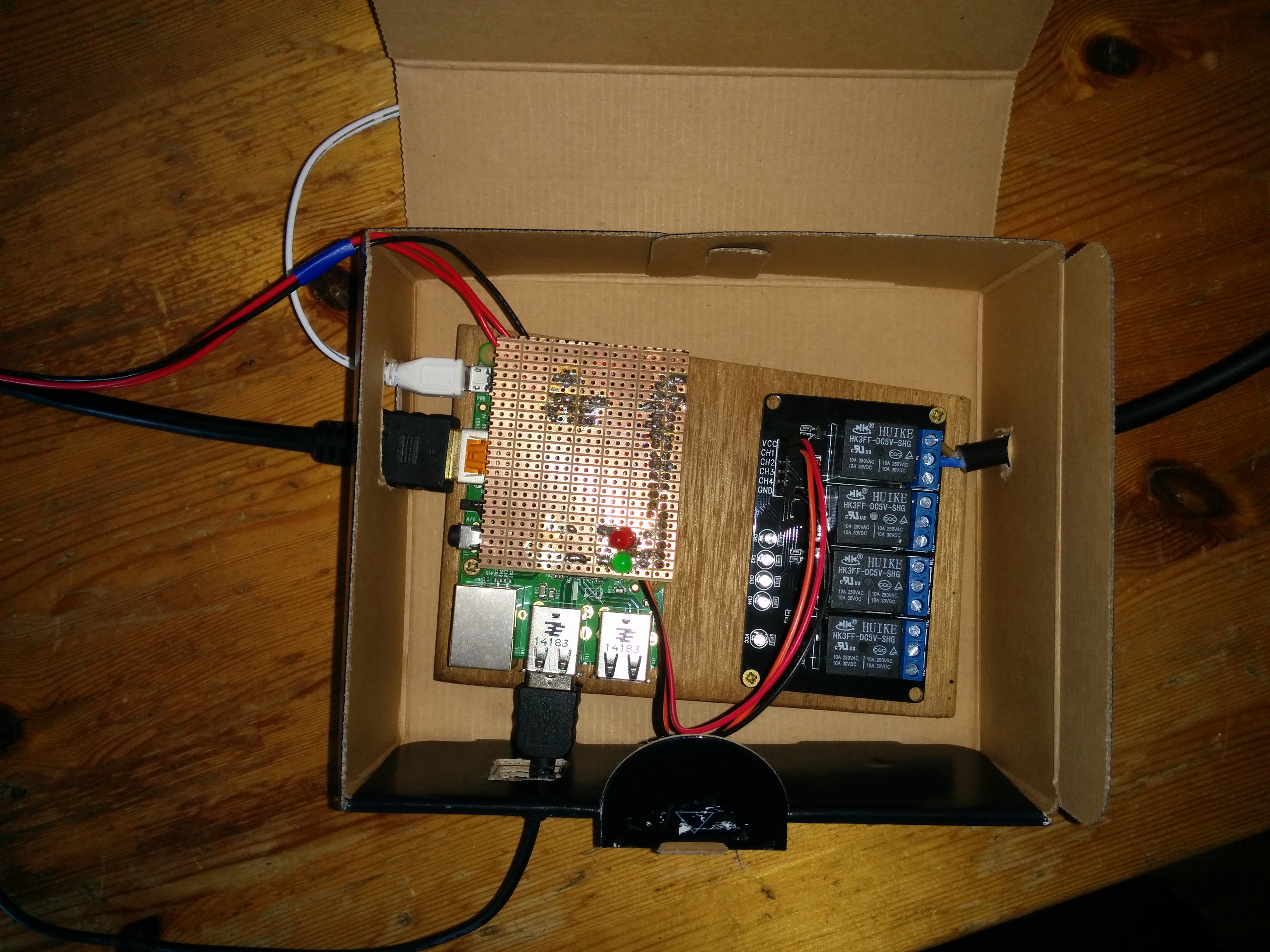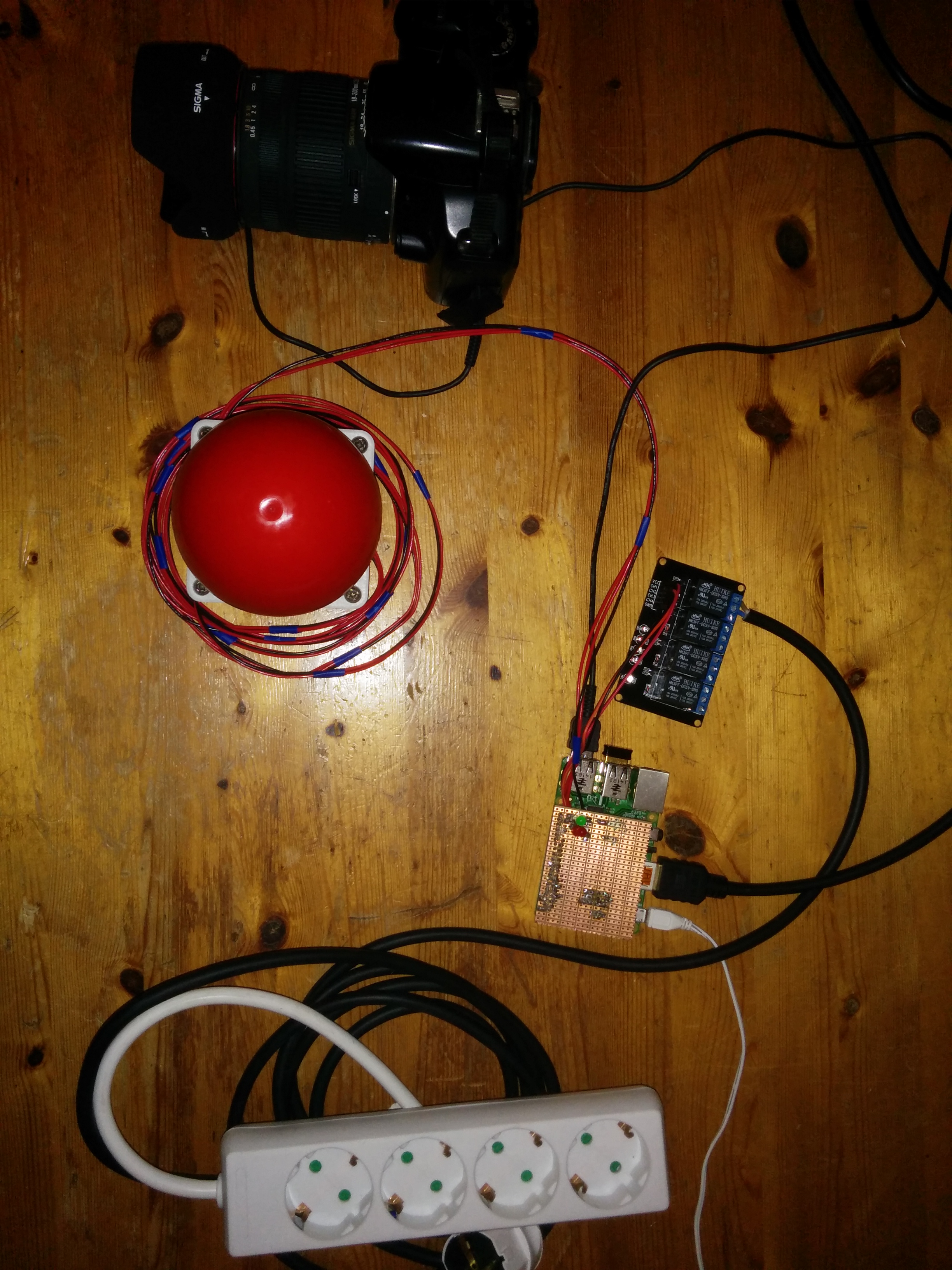Lightbooth in a box
Lightbooth with all peripherals visible:
- Connect camera via USB to RPI. The camera should be set to M or P (preferably). Make sure the camera has sleep mode and/or battery saver disabled.
- Connect button and relay to RPI, see picture of breakout board
- Connect screen to RPI via HDMI
- Put the socket in the wall, connect a light to the socket
- Connect 5v USB adapter to RPI. Make sure it has enough Ampere for the number of lights connected to the relay
Connections of relay (black, red, orange wires with blue tape) and button (black, red, red wires):
cd lightbooth;
sudo python lightbooth.py
- When lightbooth is running, the green led on the breakout board will be on.
- Once lightbooth is ready to take pictures it will display "ready for action" on the command line, and "Push the button" on the screen connected via HDMI.
- When the button is clicked, the screen connected to HDMI will count down from
count_down_secondsto 0, display 'smile :)', and take a picture. - When a picture is being taken, the lights connected to the wall socket will switch off and the red led on the breakout board will turn on.
- Once the picture has been taken, the lights connected to the wall socket will switch back on, and the red led on the breakout board will turn off.
- The screen connected to HDMI will display 'transferring picture' until the picture is loaded on screen.
- You can now click the button again to take a new picture.
- To view the captured images as a slideshow, use a computer which is on the same network as lightbooth. Open your browser and specify the following address: http://IP_ADDRESS/slideshow.
- The slideshow continually loops over all the captured images, in the order with which they were captured.
- When a new image is taken with lightbooth, the slideshow will show this picture and then continue its normal routine again.
- The high-res version of the picture is stored in /home/pi/lightbooth/images
- A center square, lower res, version of the picture is stored in /home/pi/lightbooth/images/instagram. This picture also has the
anomaly_imgembedded. - A samba share called 'lightbooth' has been set up on the same dir. Connect with raspberry pi credentials to be able to modify the contents of this dir; default is view only.
- If you see "command given gphoto2 ..." on the command line, but don't hear the camera click, restart lightbooth.
show_hashtagcan be set to true to watermark all images at the bottom middlehashtagcan be set to any alphanumeric string to watermark all imagesdo_count_downcan be set to true to show a count down on screen before before an image is takencount_down_secondsdetermines the number of seconds to count down on screen before an image is takenupload_to_instagramcan be set to true to automatically upload images to instagram. Make sure to set$username,$password, and$captionto the desired values in instagram.php.anomaly_imgis used to water mark the images (bottom right). Values can be anomaly_transparent_white.png or anomaly_transparent_black.png (or any other image in /home/pi/lightbooth)
Note: if the image falls off screen, edit /boot/config.php and set disable_overscan=0
Gphoto2 is used to remote control the camera via USB. Before starting up lightbooth, you'll first need to make sure gphoto2 is configured properly.
For a Canon D6, a good configuration for light painting is as follows: aperture 22, iso 800, shutter speed 10, imageformat jpeg. This amounts to the following gphotos settings, to be set via the command line before you start lightbooth:
sudo gphoto2 --set-config /main/capturesettings/shutterspeed=15
sudo gphoto2 --set-config /main/imgsettings/iso=4
sudo gphoto2 --set-config /main/capturesettings/aperture=15
sudo gphoto2 --set-config /main/imgsettings/imageformat=1
For a Canon 550D, the following should be set via the command line before you start lightbooth::
sudo gphoto2 --set-config /main/capturesettings/shutterspeed=6
sudo gphoto2 --set-config /main/imgsettings/iso=4
sudo gphoto2 --set-config /main/capturesettings/aperture=22
sudo gphoto2 --set-config /main/imgsettings/imageformat=1
To experiment with other values, use the following on the command line:
sudo gphoto2 --list-config # for an overview of all configurable parameters
sudo gphoto2 --get-config /main/capturesettings/shutterspeed # for an overview of all shutter speed values
sudo gphoto2 --get-config /main/imgsettings/iso # for an overview of all iso values
sudo gphoto2 --get-config /main/capturesettings/aperture # for an overview of all aperture values
Keep in mind, wired is always more reliable on pi. Nevertheless:
- sudo nano /etc/wpa_supplicant/wpa_supplicant.conf
- Go to the bottom of the file and add the following:
network={
ssid="The_network_name"
psk="Your_wifi_password"
}
- see here for more elaborate instructions
Example config for a static IP address
- sudo nano /etc/network/interfaces
auto wlan0
allow-hotplug wlan0
iface wlan0 inet static
address 192.168.1.111
gateway 192.168.1.1
dns-nameservers 8.8.8.8
netmask 255.255.255.0
wpa-conf /etc/wpa_supplicant/wpa_supplicant.conf
Download and install Raspian.
Update Raspian
sudo apt-get update
sudo apt-get upgrade
Install newest version of gphoto from source (takes a while)
wget https://raw.githubusercontent.com/gonzalo/gphoto2-updater/master/gphoto2-updater.sh && chmod +x gphoto2-updater.sh && sudo ./gphoto2-updater.sh
Install Adafruit GPIO Library
git clone http://github.com/adafruit/Adafruit-Raspberry-Pi-Python-Code.git
Install the Python GPIO libraries for accessing the pins in python + install pygame which will be used as display + install php5 things for uploading to instagram
sudo apt-get install python-dev python-rpi.gpio python-pygame python-setuptools php5-cli php5-curl
If screen has black borders, do the following
sudo nano /boot/config.txt
Set disable_overscan=1
Git clone this repo: git clone git@github.com:ErikBorra/lightbooth.git
To enable the slideshow:
sudo apt-get install apache2 php5 libapache2-mod-php5 -y
cd /var/www; sudo ln -s /home/pi/lightbooth/www slideshow


